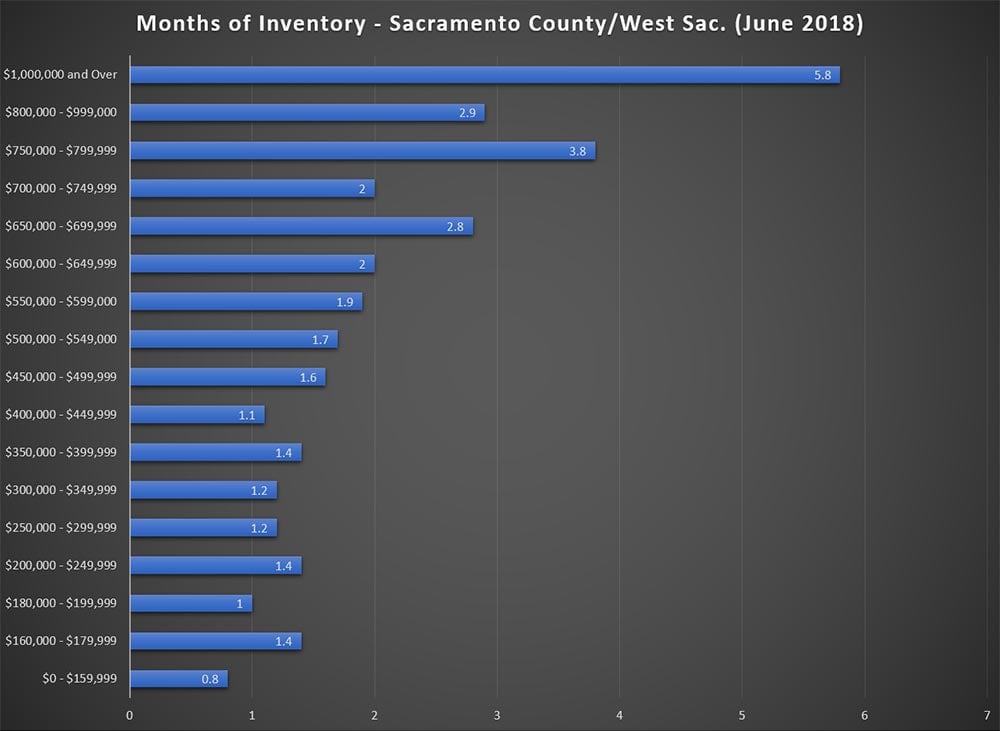As we move past the middle of the year and 2019 looms on the horizon, a wealth of midyear real estate market data has become available. The California Association of Realtors (CAR) has released their June 2018 California Housing Market Update. In addition, we can look to other sources for information on the Sacramento region, such as Zillow and Trulia, and the Sacramento Association of Realtors (SAR).

Prices continue to climb across California, and in Sacramento in particular.
According to SAR, the median sales price of homes in Sacramento held steady at $375,000, with a year-to-date median of $364,000. In June 2017, the median sales price was just shy of $350,000.
California-wide, CAR’s median sales price reached a new record high of $602,760, an increase of nearly $50,000 over June 2017. The median price per square reached $290 (versus $270 in June 2017), the highest since December 2007.
Housing inventory is extremely low, well within the territory of a seller’s market.
Typically, anything less than six months of unsold inventory on the market is indicative of a seller’s market. In June 2018, CAR’s unsold inventory index for the state indicated that there was 3 months of inventory. This is an increase of 0.3 months over June 2017, but still very low. However, this is tilted in favor of lower cost homes. There is currently a glut of very high-end homes, with 7.8 months of inventory available for homes over $3 million.
Meanwhile, housing inventory in Sacramento County and West Sacramento is incredibly tight, with only 1.5 months of inventory as of June 2018. Supply was by far the greatest for homes over $1,000,000, with 5.8 months of inventory, while no single price bracket below $450,000 had more than 1.4 months of inventory.

As inventory continues to be scarce, sales volume has declined throughout California.
410,800 SFRs were sold in 2018, a decline of more than 7% versus the previous June. This decline was felt most keenly in Southern California, where sales dropped by 12% YOY. This continues a trend going back to the beginning of the year. Meanwhile, the Bay Area experienced an 8% decline, and the Central Valley a decline of 6%.
YOY sales also declined in Sacramento—though by a far lesser degree that elsewhere—dropping by just over 3%.
This decline in volume correlates heavily with listing prices. Statewide, sales volumes declined YOY for every price segment except homes over $1 million.
Throughout California, the median time on market has reached almost record lows, with Sacramento outpacing the state average.
Since 2005, the record low time-on-market figure is approximately 14 days, achieved in mid-2017. While this figure subsequently jumped to more than 30 days, we have experienced a steady decline. In June 2018 the median DOM reached 15 days.
In Sacramento, more than 80% of properties have been on the market less than 30 days, and more than 92% have been on the market less than 60 days. Overall, the median DOM was 10 days in June, a slight increase from 9 days in May.
Having just come through a period of significant price appreciation, and with the Fed set to increase the prime rate again, prices are overdue for a reversal.
Statewide, we have seen a seasonal decline in prices every fall since 2010. Between the nearly 10% increase in price, and the Federal Reserve signaling they would raise rates in September and December, there is no reason to believe that we won’t experience a similar correction over the next few months.
Higher interest rates will likely have a major impact on the market. It will become more difficult for new buyers, and those looking to upgrade, to afford current prices. We expect the current trend for days-on-market to reverse, and inventory on the market will continue to increase.
Of course, this is educated guesswork based upon the data on hand and previous historic trends. We will continue to watch the markets closely and react as necessary for the benefit of both borrowers and investors.
